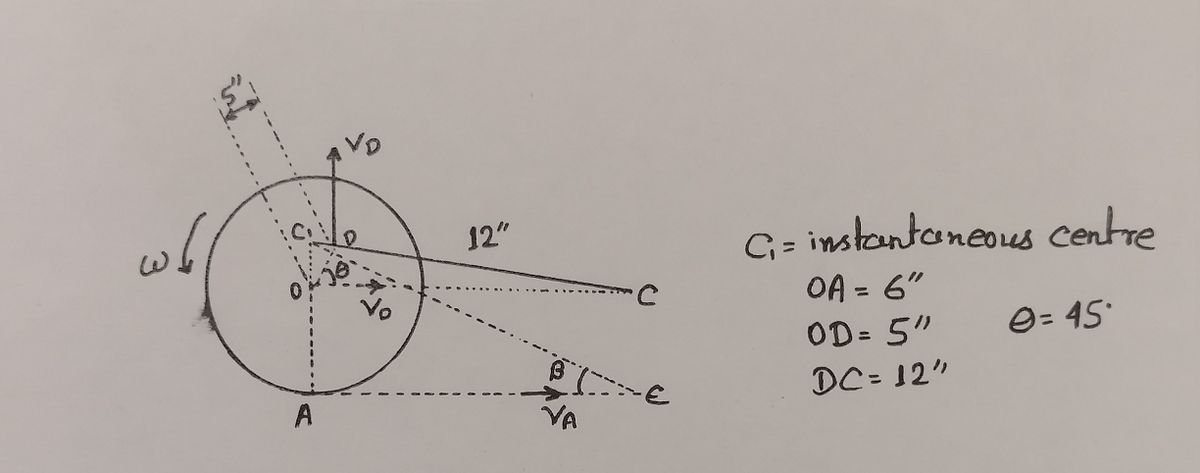The device shown tests wear of two bearing materials A and B by applying motion to the rod EO. If EO has a rightward speed of 4 ft/s when 0-45°, find the velocity of the surface A in contact with stationary surface B. 6 A B 12"
The device shown tests wear of two bearing materials A and B by applying motion to the rod EO. If EO has a rightward speed of 4 ft/s when 0-45°, find the velocity of the surface A in contact with stationary surface B. 6 A B 12"
Elements Of Electromagnetics
7th Edition
ISBN:9780190698614
Author:Sadiku, Matthew N. O.
Publisher:Sadiku, Matthew N. O.
ChapterMA: Math Assessment
Section: Chapter Questions
Problem 1.1MA
Related questions
Question

Transcribed Image Text:**Transcription for Educational Website:**
**Title: Analyzing Bearing Material Wear Through Motion Application**
**Description and Problem Statement:**
The device illustrated is designed to test the wear of two bearing materials, labeled as \( A \) and \( B \), by inducing motion through the rod \( EO \). In the scenario presented, \( EO \) is moving to the right with a velocity of 4 feet per second (\( \text{ft/s} \)) at an angle \( \theta = 45^\circ \). The task is to determine the velocity of the surface \( A \) as it remains in contact with the stationary surface \( B \).
**Diagram Explanation:**
- The diagram shows a mechanical assembly with rods and angles.
- The rod \( EO \) is connected to a mechanism that rotates a segment labeled \( A \).
- Rod \( DC \) is another component, positioned at \( 12^\circ \) relative to a horizontal base.
- The angle \( \theta \) represents the rotation of the segment around a central point, depicted as \( 6^\circ \).
- The point \( D \) on the diagram indicates a pivotal connection enabled by the apparatus.
- Surface \( B \) remains stationary, providing a reference for measuring the motion and wear of surface \( A \).
**Objective:**
The primary goal is to calculate the velocity at which surface \( A \) moves while maintaining contact with surface \( B \) when the rod \( EO \) is moving rightward at the given speed and angle condition.
**Instructions for Calculation:**
To find the velocity of surface \( A \), apply the principles of relative motion and geometry linking the specified components and angles. Ensure to consider the rotational aspects and the given constraints.
Expert Solution
Step 1

Step by step
Solved in 2 steps with 2 images

Knowledge Booster
Learn more about
Need a deep-dive on the concept behind this application? Look no further. Learn more about this topic, mechanical-engineering and related others by exploring similar questions and additional content below.Recommended textbooks for you

Elements Of Electromagnetics
Mechanical Engineering
ISBN:
9780190698614
Author:
Sadiku, Matthew N. O.
Publisher:
Oxford University Press

Mechanics of Materials (10th Edition)
Mechanical Engineering
ISBN:
9780134319650
Author:
Russell C. Hibbeler
Publisher:
PEARSON

Thermodynamics: An Engineering Approach
Mechanical Engineering
ISBN:
9781259822674
Author:
Yunus A. Cengel Dr., Michael A. Boles
Publisher:
McGraw-Hill Education

Elements Of Electromagnetics
Mechanical Engineering
ISBN:
9780190698614
Author:
Sadiku, Matthew N. O.
Publisher:
Oxford University Press

Mechanics of Materials (10th Edition)
Mechanical Engineering
ISBN:
9780134319650
Author:
Russell C. Hibbeler
Publisher:
PEARSON

Thermodynamics: An Engineering Approach
Mechanical Engineering
ISBN:
9781259822674
Author:
Yunus A. Cengel Dr., Michael A. Boles
Publisher:
McGraw-Hill Education

Control Systems Engineering
Mechanical Engineering
ISBN:
9781118170519
Author:
Norman S. Nise
Publisher:
WILEY

Mechanics of Materials (MindTap Course List)
Mechanical Engineering
ISBN:
9781337093347
Author:
Barry J. Goodno, James M. Gere
Publisher:
Cengage Learning

Engineering Mechanics: Statics
Mechanical Engineering
ISBN:
9781118807330
Author:
James L. Meriam, L. G. Kraige, J. N. Bolton
Publisher:
WILEY